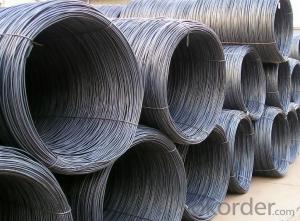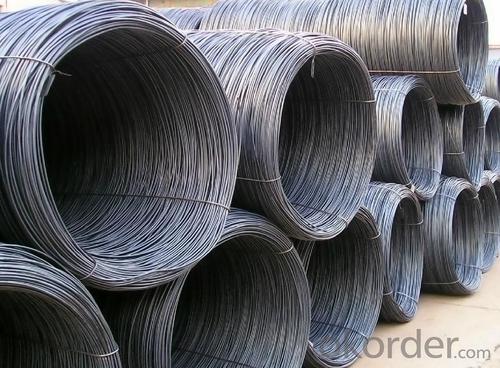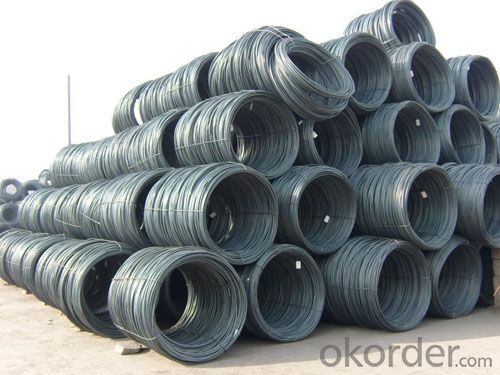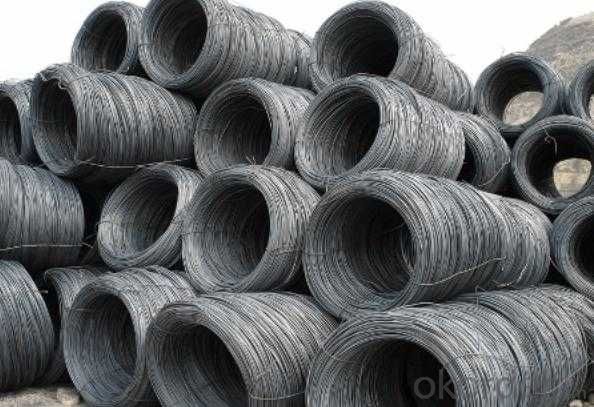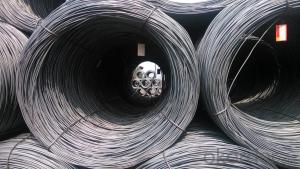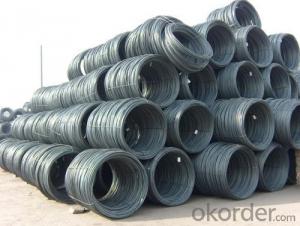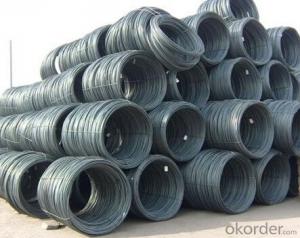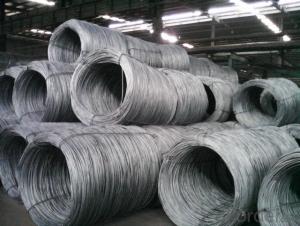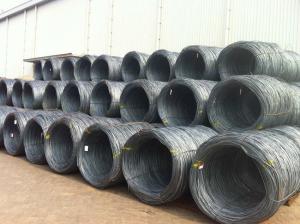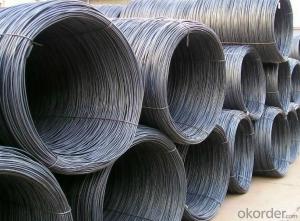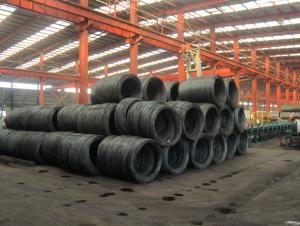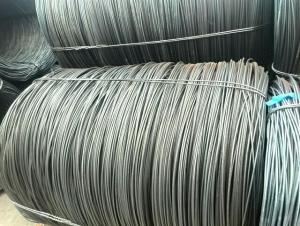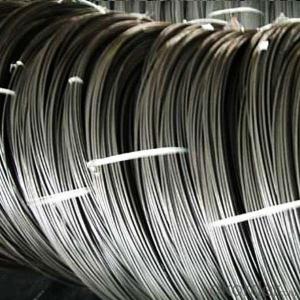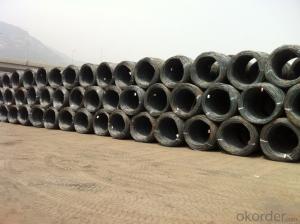GB Standard Q195 Steel Wire Rod with High Quality
- Loading Port:
- China Main Port
- Payment Terms:
- TT or LC
- Min Order Qty:
- 40 m.t
- Supply Capability:
- 15000 m.t/month
OKorder Service Pledge
OKorder Financial Service
You Might Also Like
Product Description:
Specifications of GB Standard Q195 Steel Wire Rod with High Quality:
Steel Grade: Q195 Standard:GB
Diameter: 5.5mm
6.5mm can be drawing into 2mm/8.0mm can be drawing into 3mm
Type: Drawn Wire in Coil, each coil weight about 2MT
Chemical Composition:
Please kindly find our chemistry of our material based on Q195 as below for your information
Trademark | Rank | Chemical composition (quality score) % | |||||
C | Si | Mn | S | P | |||
| ≤ |
| ≤ | ≤ | |||
Q195 |
| 0.06-0.12 | 0.30 | 0.25 | 0.050 | 0.045 | |
Trademark | Rank | Pulling Test | |||||
Bend PointΔs/Mpa | Tensile Strength | Elongation Ratioδ5% | |||||
Thickness (Diameter) /MM | Thickness (Diameter) /MM | ||||||
≤16 | 16-40 | ≤16 | 16-40 | ||||
≥ | ≥ | ||||||
Q195 |
| 195 | 185 | 315-390 | 33 | 32 | |
Usage and Applications of GB Standard Q195 Steel Wire Rod with High Quality:
After hot-rolled the products shaped into coil and delivery as finished product, including round, square, rectangular, hexagonal and so on. Since most of the products are round, it is generally called wire rod. Carbon steel wire rod is widely used in construction and manufacturing. Carbon steel wire rod is mainly used for reinforcement of reinforced concrete and welded structure or reprocessed (roberts , nail, etc.) materials, especially used to produce wire drawing, welding electrode, nails, spring, electronic, precise machinery parts and so on.
Production Process of GB Standard Q195 Steel Wire Rod with High Quality:
Steel billet---Heating---Rolling---Water-cooling---Coiling---Cooling---Inspection---Bundling---Exworks
Packaging & Delivery of GB Standard Q195 Steel Wire Rod with High Quality:
Packaging Detail: products are packed in coil and then shipped by container or bulk vessel
Each coil weight: About 2MT
Delivery Detail: within 45 days after received deposit or LC.
Label: to be specified by customer, generally, each bundle has 1-2 labels
Trade terms: FOB, CFR, CIF
FAQ:
Q1: How soon can we receive the product after purchasement?
A1: Within three days of placing an order, we will begin production. The specific shipping date is dependent upon international and government factors, but is typically one month.
Q2: How do you guarantee the quality of our products?
A2: We have established an advanced quality management system which conducts strict quality tests at every step, from raw materials to the final product. At the same time, we provide extensive follow-up service assurances as required.
Q3: The prices are invoicing on theoritical weight or on actual weight?
A3: We can do it in both manners, according to the customers' request.
Images of GB Standard Q195 Steel Wire Rod with High Quality:
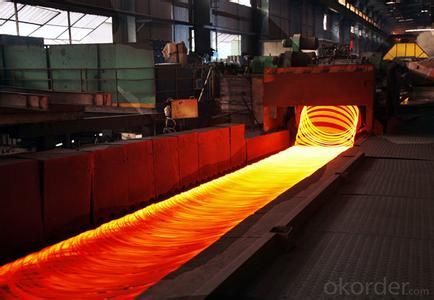
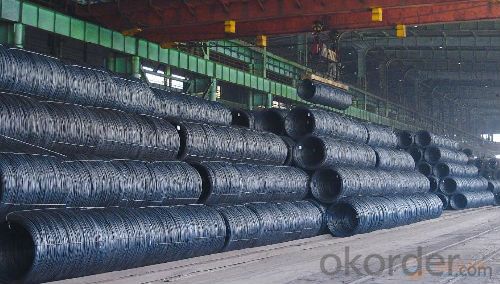
*If you would like to get our price, please kindly inform us the size, standard/material and quantity. Thank you very much for your attention.
- Q: How does the magnetic properties of steel wire rod vary with different grades?
- The magnetic properties of steel wire rod vary with different grades due to the varying composition and microstructure of the steel. High carbon steel wire rods, for example, have a lower magnetic permeability and are less magnetic compared to low carbon steel wire rods. Additionally, the presence of alloying elements such as nickel or chromium can affect the magnetic properties. In general, the higher the carbon content and the more alloying elements present, the lower the magnetic properties of the steel wire rod.
- Q: What are the common industry skills for steel wire rod suppliers?
- Some common industry skills for steel wire rod suppliers include knowledge of steel manufacturing processes, understanding of quality control and inspection procedures, expertise in handling and storing steel wire rods, ability to interpret technical specifications, proficiency in inventory management, strong communication and negotiation skills, and familiarity with market trends and customer demands.
- Q: What are the different types of steel wire rod surface finishes after wire drawing?
- Wire drawing can result in various surface finishes for steel wire rods. These finishes serve multiple purposes, such as improving wire performance, safeguarding it from corrosion, and protecting it from environmental factors. Here are some commonly used surface finishes for steel wire rods: 1. Bright finish: After wire drawing, the wire retains its natural state, resulting in a shiny, reflective surface. This finish is suitable for applications where aesthetics are not a primary concern. 2. Galvanized finish: To prevent corrosion, the wire is coated with a layer of zinc. Galvanized wire has a matte appearance and is commonly utilized in outdoor settings exposed to moisture and harsh conditions. 3. Phosphated finish: Through a chemical process called phosphating, the wire receives a phosphate coating that enhances its corrosion resistance and adhesion properties. This finish is ideal for applications involving high temperatures or corrosive environments. 4. Coated finish: A protective layer of polymer or another material is applied to the wire's surface. Coated wire possesses a smooth, uniform appearance and is often used when insulation or abrasion protection is necessary. 5. Nickel-plated finish: The wire undergoes a process where it is coated with a layer of nickel. This finish enhances corrosion resistance and improves the wire's appearance, resulting in a bright, shiny surface. Nickel-plated wire is frequently employed in decorative applications or environments exposed to moisture and corrosive substances. These examples demonstrate the variety of steel wire rod surface finishes obtainable after wire drawing. The selection of a specific finish depends on the application's requirements and the desired properties of the wire.
- Q: What are the common production processes for platinum-coated steel wire rod?
- The common production processes for platinum-coated steel wire rod typically involve several steps. First, the steel wire rod is cleaned and prepared by removing any impurities and applying a lubricant to enhance the coating process. Then, the platinum coating is applied using various methods such as electroplating or chemical vapor deposition. This ensures a uniform and durable layer of platinum on the steel wire rod. Finally, the coated wire rod is subjected to quality checks and may undergo additional processes such as annealing or heat treatment to improve its mechanical properties.
- Q: How long does it take to produce steel wire rod from raw materials?
- Several factors can influence the production process of steel wire rod from raw materials. These factors include the specific manufacturing method, equipment utilized, and the desired quality and specifications of the final product. The process typically involves several stages, such as iron ore extraction, ironmaking, steelmaking, casting, and rolling. Iron ore extraction necessitates the mining and processing of iron-rich rocks or minerals. The duration of this process can vary depending on the size and location of the mine. Once the iron ore is extracted, it undergoes a series of procedures, including crushing, grinding, and beneficiation. These steps serve to eliminate impurities and enhance the quality of the ore for steel production. The subsequent stage is ironmaking, where the processed iron ore is converted into molten iron. This transformation is achieved through a blast furnace or direct reduction process. The duration of this stage can depend on the efficiency and size of the furnace and may take several hours to complete. Steelmaking, also referred to as primary steel production, involves the conversion of molten iron into steel by eliminating excess carbon and other impurities. This process is typically conducted in a basic oxygen furnace or electric arc furnace and may require several hours to finish. Once the steel is produced, it must be cast into semi-finished products such as billets or blooms. The duration of this step can range from several minutes to hours, depending on the casting method and equipment employed. Lastly, the steel is shaped into wire rod through the rolling process. This involves passing the steel through a series of rolling mills to reduce its diameter and achieve the desired dimensions. The duration of rolling can vary from a few minutes to several hours, depending on the required length and thickness of the wire rod. In summary, the time required to produce steel wire rod from raw materials can significantly differ based on the specific processes, equipment, and quality standards involved. Generally, the production process can span from several hours to several days.
- Q: What are the advantages of using steel wire rod compared to other materials?
- There are several advantages of using steel wire rod compared to other materials. Firstly, steel wire rod offers high strength and durability, making it suitable for various applications where a strong material is required. Secondly, steel wire rod has excellent flexibility, allowing it to be easily bent or shaped without breaking, which makes it ideal for applications that require flexibility, such as in construction or manufacturing. Additionally, steel wire rod has good corrosion resistance, ensuring its longevity and suitability for outdoor or corrosive environments. Lastly, steel wire rod is widely available and cost-effective, making it a cost-efficient choice for many industries.
- Q: How is steel wire rod used in the production of wire mesh?
- Wire mesh production relies heavily on steel wire rod, which serves as a vital component. This versatile material, also known as wire cloth or wire fabric, finds application in numerous industries for various purposes. To initiate the wire mesh production, steel wire rod undergoes hot rolling, a process wherein molten steel is passed through rollers to form a continuous, elongated rod with a specific diameter. The diameter of the steel wire rod may vary based on the desired end product and application of the wire mesh. After the production of steel wire rod, it is drawn through dies to further reduce its diameter. This drawing process not only reduces the diameter but also enhances the wire's tensile strength and surface finish. Consequently, the drawn wire becomes suitable for utilization in wire mesh production. The wire mesh machine is responsible for processing the steel wire rod. It undergoes a series of procedures to form the wire mesh. Initially, the wire is straightened and cut to the required length. These cut wire lengths are then fed into a weaving machine, where they are interwoven to create the desired mesh pattern. The wire mesh machine employs various techniques, including plain weave, twill weave, or Dutch weave, to manufacture different types of wire mesh. The steel wire rod functions as the fundamental building block for these patterns, providing the necessary strength and durability for the wire mesh to withstand diverse applications. Once the wire mesh is woven, it proceeds through additional processes, such as galvanizing or coating, to enhance its properties. Galvanizing involves applying a zinc coating to protect the wire mesh from corrosion, while coating can provide additional attributes such as heat resistance, chemical resistance, or abrasion resistance. In conclusion, steel wire rod plays a vital role in wire mesh production. It serves as the starting material, undergoes processing and weaving to create various wire mesh patterns, and offers the requisite strength and durability for applications across different industries.
- Q: What are the main factors influencing the choice of steel wire rod order cancellation policy?
- The choice of cancellation policy for steel wire rod orders is influenced by several key factors. These factors include market conditions, manufacturing lead time, cost implications, customer relationships, and legal and contractual obligations. 1. Market conditions: The cancellation policy is determined by the current state of the market. If there is high demand and limited supply, the policy may be stricter to maintain a smooth supply chain. Conversely, if the market is experiencing a downturn with low demand, the policy may be more flexible to accommodate changes in customer requirements. 2. Manufacturing lead time: The lead time required to produce steel wire rods is an important consideration for the cancellation policy. If the lead time is long, the policy may be more stringent to avoid unnecessary production or inventory costs caused by cancellations. On the other hand, if the lead time is short, the policy may be more flexible as adjustments to the production schedule can be made quickly. 3. Cost implications: The cancellation policy takes into account the costs associated with cancelling an order. This includes costs related to raw material procurement, production setup, and storage. If the cancellation costs are high, the policy may be more strict to minimize financial losses for the manufacturer. 4. Customer relationships: The nature of the relationship between the manufacturer and the customer can influence the cancellation policy. If there is a long-standing and strong relationship, the manufacturer may be more accommodating to cancellations in order to maintain customer satisfaction and loyalty. Conversely, if the relationship is new or strained, the policy may be stricter to protect the manufacturer's interests. 5. Legal and contractual obligations: Legal and contractual obligations are also important factors in determining the cancellation policy. The manufacturer must ensure compliance with any legal requirements or contractual agreements with the customer. These obligations may dictate the terms and conditions for order cancellations, including any penalties or liabilities. In conclusion, the cancellation policy for steel wire rod orders is shaped by market conditions, manufacturing lead time, cost implications, customer relationships, and legal and contractual obligations. Manufacturers must carefully consider these factors in order to find a balance between meeting customer needs and safeguarding their own interests.
- Q: How is steel wire rod used in the manufacturing of wire ties for construction sites?
- Steel wire rod is used in the manufacturing of wire ties for construction sites by being drawn through a series of dies to reduce its diameter and increase its length. This process results in a strong and durable wire that is then cut into the desired lengths and bent into the shape of wire ties. These wire ties are widely used in construction sites to secure and hold together various building materials, such as rebar, pipes, or electrical wires, ensuring structural stability and safety.
- Q: What are the potential applications of stainless steel wire rod?
- The unique properties and versatility of stainless steel wire rod make it suitable for a wide range of applications. Some of these applications include: 1. Construction and infrastructure: Stainless steel wire rod is often used in construction and infrastructure projects due to its strength, durability, and resistance to corrosion. It can be utilized in the production of reinforcement bars, concrete structures, bridges, and other crucial infrastructure components. 2. Automotive industry: Stainless steel wire rod is employed in the manufacturing of different automotive components, such as exhaust systems, suspension springs, and engine parts. Its excellent resistance to heat, corrosion, and high temperatures makes it ideal for demanding automotive applications. 3. Aerospace industry: The lightweight nature and high strength-to-weight ratio of stainless steel wire rod make it suitable for the aerospace industry. It is used in the production of aircraft components, including fasteners, cables, and structural elements, where corrosion resistance and mechanical properties are vital. 4. Medical equipment: Stainless steel wire rod is widely used in the production of medical equipment and instruments due to its biocompatibility, corrosion resistance, and ease of sterilization. Surgical tools, implants, orthodontic wires, and other medical devices are made using stainless steel wire rod. 5. Power generation: The power generation industry utilizes stainless steel wire rod for its excellent resistance to high temperatures, pressure, and corrosion. It is commonly used in the production of turbine blades, heat exchangers, and other critical components in power plants. 6. Food processing industry: Stainless steel wire rod is extensively used in the food processing industry because of its hygienic properties and resistance to corrosion. It is employed in the production of food handling equipment, storage tanks, and processing machinery. 7. Wire products: Various wire products, such as springs, wire mesh, cables, and fencing, are made using stainless steel wire rod. Its high tensile strength, corrosion resistance, and flexibility make it suitable for these applications. 8. Marine industry: The marine industry relies on stainless steel wire rod for its resistance to corrosion in saltwater environments. It is used in the production of marine equipment, boat fittings, rigging, and other components. In conclusion, stainless steel wire rod has vast and diverse potential applications, spanning across industries such as construction, automotive, aerospace, medical, power generation, food processing, wire products, and the marine sector. Its exceptional properties make it a reliable and preferred material for critical applications that require strength, durability, and corrosion resistance.
Send your message to us
GB Standard Q195 Steel Wire Rod with High Quality
- Loading Port:
- China Main Port
- Payment Terms:
- TT or LC
- Min Order Qty:
- 40 m.t
- Supply Capability:
- 15000 m.t/month
OKorder Service Pledge
OKorder Financial Service
Similar products
Hot products
Hot Searches
Related keywords
